The most common types of siding material are attached horizontally, starting at the bottom of the house. Each type of siding has nuances as to how it's attached to the exterior of your house. There are also tools and blades designed specially to cut and install some siding materials. Make sure you use the proper tool for the type of exterior material you choose to cover the outside of your home. Shown on the following pages are the most common ways to install vinyl siding and cedar siding, along with a few tips on working with fiber cement siding.
CUTTING VINYL SIDING
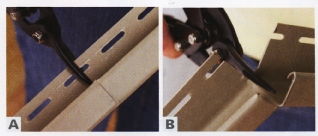
A. Measure and mark the piece of vinyl siding to fit. Use snips to
cut through the flanges. B. Continue to cut through the material, cutting
the rest of the J-flange.
INSTALLING VINYL SIDING
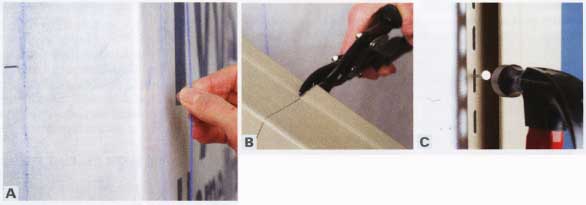
A. Measure and cut a corner post, so that there will be a 1/2-in.
(13-mm) gap between the top of the post and the eave of the house.
B. Measure the length of siding needed. Mark and cut the piece to
length. C. Nail the corner post at the top of the post. Check for plumb.
Fasten the posts every 12 in (305 mm).

D. Determine the lowest part of the wall that will
be sided. Make a chalk line across the house for the first horizontal
piece. E. Lay
out the top of the strip along the chalk line. Check for level. F.
Nail the starter strip to the house every 10 in. (255 mm). G.
Miter the ends of a i-channel trim piece to fit two channel widths
wider than opening of window. Attach the trim piece under window.
(Full-size of above image).
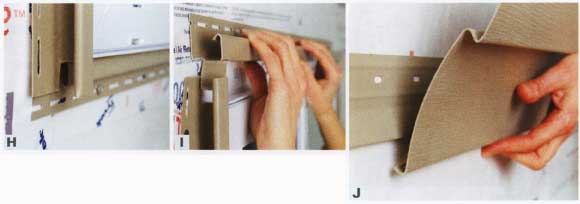
H. Cut the side trim pieces to length, and install
them on either side of the window. I. Nail the trim
piece in place on top of the window.
J. Cut the first piece of siding to length. Install
over the starter strip from step F.
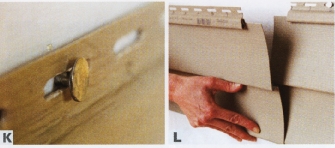
K. Nail each siding piece so that it isn't driven all of the way
into the house. There should be a gap of about 1/4 in (3 mm). L. Overlay
each successive piece of siding to cover the house.
OVERLAPPING SIDING

A. When planning to overlap siding, you may want to overlap the material
so that the top piece is closest to the house’s front door. B. By overlapping
away from the house, the siding appears seamless when looking at
the exterior from the front door.
INSTALLING CEDAR SIDING
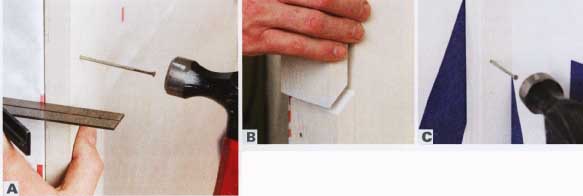
A. Cedar siding offers a few options for treating corners. Mitering
is a popular option to create a neat finish. The technique here uses
corner boards. They are sized according to the siding’s thickness,
but are often 3/4-in. (19-mm) or 1-1/4-in. (32-mm) material. Check
that each piece is flush with the house before nailing it in place.
B. Continue cutting the corner bead pieces to fit along the corner
joint. C. Nail the corner bead in place. Fill any joints with caulk
to seal.

D. Cut and attach a furring strip to support the lower
edge of the first board. E. Face nail to studs penetrating
1-1/4 in (32 mm) into solid wood. Use one ring shank nail per bearing
spaced at maximum 24 in. (610 mm) on center. F. Cut and install each row to length. Use a foam brush to apply sealant. G.
Make sure that each course overlaps the previous by about 1 in. (25
mm) to allow for shrinkage. Do not overlap more than 2 in. (50 mm).
INSTALLING FIBER CEMENT SIDING
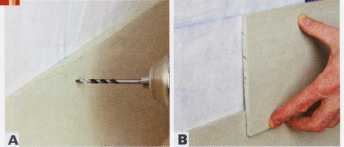
A. Drive galvanized siding nails or screws through the top of each
length of siding into the studs. You may want to make pilot holes.
B. Each row overlaps the row below, (as with cedar siding, above).
Create an overlap of at least a 1-1/2 in (38 mm) to cover up the fasteners.
FIBER CEMENT TOOLS
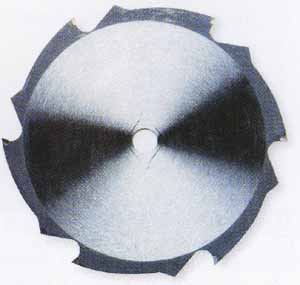
Fiber cement siding can be tougher to cut than wood or vinyl siding.
Manufacturers have created special tools and blades to help you cut
through the material, making it almost as easy as cutting through wood.
You can use a special scoring tool, or a carbide- tipped blade in a
circular saw (shown above: FIBER CEMENT BLADE).